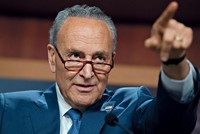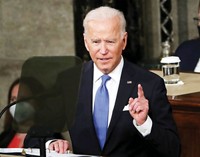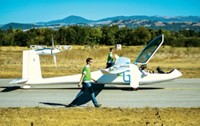Advertisement
Grab your lab coat. Let's get started
Welcome!
Welcome!
Create an account below to get 6 C&EN articles per month, receive newsletters and more - all free.
It seems this is your first time logging in online. Please enter the following information to continue.
As an ACS member you automatically get access to this site. All we need is few more details to create your reading experience.
Not you? Sign in with a different account.
Not you? Sign in with a different account.
ERROR 1
ERROR 1
ERROR 2
ERROR 2
ERROR 2
ERROR 2
ERROR 2
Password and Confirm password must match.
If you have an ACS member number, please enter it here so we can link this account to your membership. (optional)
ERROR 2
ACS values your privacy. By submitting your information, you are gaining access to C&EN and subscribing to our weekly newsletter. We use the information you provide to make your reading experience better, and we will never sell your data to third party members.
Environment
Prizes For Innovation
Policymakers look to federally funded inducement prizes to help solve societal challenges
by Britt E. Erickson
January 4, 2010
| A version of this story appeared in
Volume 88, Issue 1

Prizes designed to attain a scientific or technical goal are the policy du jour for promoting innovation and encouraging high-risk research—two areas that the Obama Administration sees as key to maintaining U.S. leadership in technological advancement. The rise in popularity of using prizes to drive innovation was evident last month at a seminar hosted by the nonprofit economic think tank Resources for the Future (RFF).
At the White House Office of Science & Technology Policy, “we see inducement prizes as an important tool for innovation. Not necessarily the only tool, but an underutilized one,” Hillary Chen, policy analyst at OSTP, noted during the seminar. Prizes are one way to help focus innovation in areas that are deemed high priority for the government, Chen said.
OSTP is considering the use of prizes to accelerate the development of new technologies, such as those for reducing energy demand. But it is also looking at prizes “outside the technological innovation space,” Chen stressed. For example, OSTP is exploring the use of prizes to reduce childhood obesity and improve graduation rates, she said.
In the current economic environment, prizes are particularly appealing because “you only pay for results,” Chen noted. “If someone crosses the finish line and comes up with what you want, then you pay. But if they don’t, then you are not in a position of paying for it.”
Ned T. Stetson, technology development manager of hydrogen storage at the Department of Energy, agreed. He emphasized that DOE has a limited budget to fund research. “By running a prize, we are able to attract a much larger pool of researchers,” Stetson said. In addition, prizes build new relationships, encourage teamwork, and improve the workplace, he added.
DOE already has such a prize in place. Under the Energy Independence & Security Act of 2007, Congress authorized DOE to award cash prizes for advances in hydrogen fuel development. This past summer, DOE launched the so-called H-prize competition, offering a $1 million award for the development of hydrogen storage materials for light-duty vehicles.
Interest in prizes for stimulating innovation increased after the success of the $10 million Ansari X Prize, awarded to aerospace designer Elbert (Burt) Rutan and financier Paul G. Allen in 2004 by the nonprofit X Prize Foundation, noted Timothy J. Brennan, a senior fellow at RFF. In that competition, teams were challenged to build and launch a three-person spacecraft 100 km above Earth’s surface twice within two weeks.
In 2006, the X Prize Foundation launched the $10 million Archon X Prize for Genomics. That prize will be awarded to the first team that can sequence 100 human genomes in 10 days.
The X Prize competitions and others like them prompted Congress to get involved. Several bills passed over the past few years authorize various federal agencies to sponsor such prizes, including the bill that created DOE’s H-prize.
Another bill, the National Aeronautics & Space Administration Authorization Act of 2005, paved the way for NASA’s Centennial Challenges, also known as prizes for the “citizen inventor.” As a result of the challenges, NASA has awarded $350,000 in prize money for improved gloves for astronaut suits, as well as cash prizes for other advances.
In 2007, the Defense Advanced Research Projects Agency launched its Urban Challenge, offering a $2 million grand prize for the best autonomous vehicle capable of driving in traffic and performing complex maneuvers without a human driver or remote control. The Urban Challenge was prompted by a congressional order that requires one-third of ground vehicles in the military to be autonomous by 2015, said Michele Gittleman, project manager of Carnegie Mellon University’s Tartan Racing team, which won the competition.
A handful of bills introduced last year in Congress further encourage federal agencies to sponsor prizes that spur innovation. For instance, policymakers proposed prizes for self-powered farms, nanotechnology, cybersecurity, and automotive energy efficiency.
It is unclear, however, whether federal agencies need authorization from Congress to sponsor a prize. “There is ambiguity over what federal agencies can and can’t do under current law,” Chen noted. “OSTP hopes to clarify what is permissible.”
OSTP is also wrestling with how to broaden the spectrum of issues that prizes address so that they benefit society as a whole. The problem is a logistical one, Chen said, adding that each federal agency requests proposals differently.
Some people question whether prizes are needed because there are many other tools for encouraging innovation, including patents, research grants, and investment tax credits. Participants at the seminar agreed that prizes should not replace more traditional sources of funding, but they stressed that there is a place for the awards.
One of the hidden benefits of prizes is that they stimulate the public’s interest in science and technology, Gittleman said. “Competitions take something that is behind the lab doors or based in a top secret location and make it public,” she noted. “When you can influence and inspire the public about a cause, you gain a lot that goes beyond the actual problem that you are trying to solve.”





Join the conversation
Contact the reporter
Submit a Letter to the Editor for publication
Engage with us on Twitter